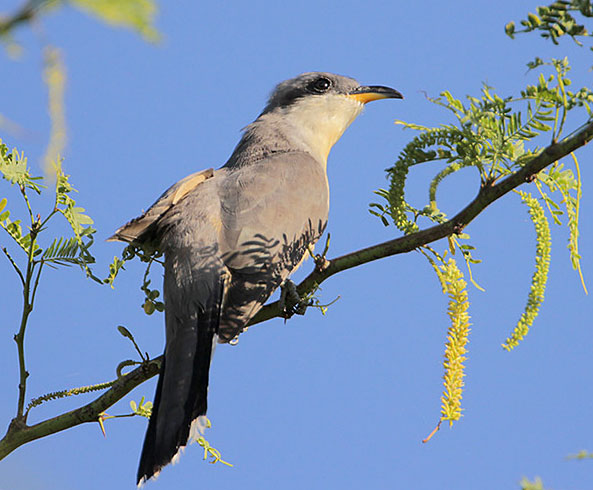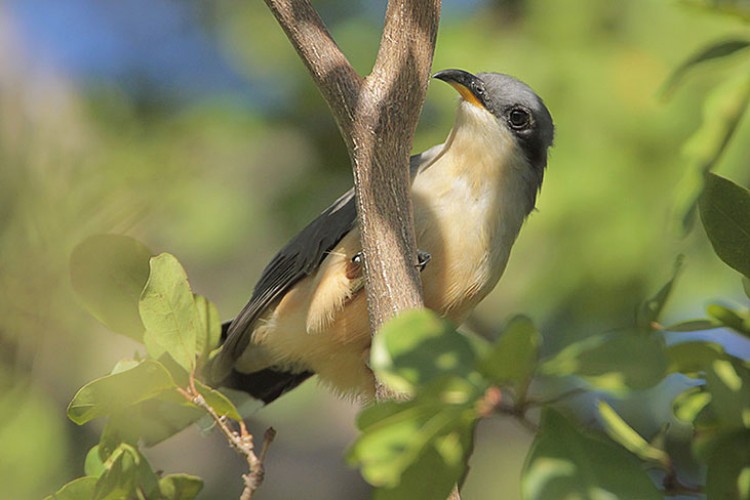Limited in its U.S. range to coastal southern Florida, and with secretive habits, the Mangrove Cuckoo’s ecology is poorly studied. Scrubby beach habitats are sometimes used, although mangrove swamps are its primary habitat. The Mangrove Cuckoo’s slow, skulking behavior makes it difficult to find.
The Mangrove Cuckoo has been shown to be area sensitive, meaning that it only occurs in larger mangrove swamps, and not smaller, fragmented ones. Preservation of large blocks of habitat will be necessary to maintain the species in Florida, its only residence north of Mexico and the Caribbean.
On this page
Description of the Mangrove Cuckoo
BREEDING MALE
The Mangrove Cuckoo is a relative of the Yellow-billed and Black-billed Cuckoos, and has a long tail marked below with large white spots, a stout bill that is black above and yellow below, a black mask through the eyes, brownish upperparts and wings, and buffy underparts.

Photograph © Greg Lavaty
Female
The sexes are similar.
Seasonal change in appearance
None.
Juvenile
Juveniles are similar to adults, but have less pronounced white tail spots.
Habitat
In the U.S., Mangrove Cuckoos inhabit mangrove swamps.
Diet
Mangrove Cuckoos eat insects, especially caterpillars.
Behavior
Mangrove Cuckoos forage slowly within dense growth.
Range
Mangrove Cuckoos are resident in south Florida, as well as the Caribbean, and Mexico south to South America. The U.S. population is declining.
Fun Facts
Mangrove Cuckoos are poorly known. Their dense, swampy, mosquito-infested habitats are difficult to work in.
There are as many as 14 subspecies of Mangrove Cuckoos throughout the entire range.
Vocalizations
The song consists of nasal cawing.
Similar Species
Yellow-billed Cuckoos are white below, and have extensive rufous coloring to their primaries that is visible in flight, and they lack the black face mask
Nesting
The Mangrove Cuckoo’s nest is a loose stick platform placed low in a tree.
Number: Usually lay 2 eggs.
Color: Bluish-green.
Incubation and fledging:
The young hatch at about 10-13 days, but it is not known at what age they leave the nest.
Bent Life History of the Mangrove Cuckoo
Published by the Smithsonian Institution between the 1920s and the 1950s, the Bent life history series of monographs provide an often colorful description of the birds of North America. Arthur Cleveland Bent was the lead author for the series. The Bent series is a great resource and often includes quotes from early American Ornithologists, including Audubon, Townsend, Wilson, Sutton and many others.
Bent Life History for the Mangrove Cuckoo – the common name and sub-species reflect the nomenclature in use at the time the description was written.
MANGROVE CUCKOO – MAYNARD’S CUCKOO
COCCYZUS MINOR MAYNARDI Ridgway
HABITS
The mangrove cuckoo (Coceyous minor minor) long remained on the A. 0. U. Check-list, including the third edition, based on Audubon’s record of a specimen taken on Key West and figured in his Birds of America. Ridgway (1916) examined this specimen and identified it as the Jamaican mangrove cuckoo (C. minor nesiotes). Now the 1931 Check-list makes the statement that all Florida records prove to be referable to C. minor maynardi, and excludes both of the above races from the list.
The mangrove cuckoo, of which Maynard’s is a subspecies, is well named, for all races of the species, seem to be confined almost exclusively to the mangroves. The only one I ever saw was encountered on our way to Alligator Lake through the mangrove forests near Cape Sable, Fla. Arthur H. Howell (1932) collected the only two be ever saw “in a black mangrove swamp near the mouth of Allens River, below Everglade.”
Nesting: Audubon (1842) says: “The nest is slightly constructed of dry twigs, and is almost flat, nearly resembling that of the Yellowbilled Cuckoo.” Mr. Howell (1932) says that “a set of two fresh eggs (now in the Florida State Museum), which the female was beginning to incubate, was taken at Chokoloskee, June 4, 1903, from a nest 7 feet up in a red mangrove.”
Oscar E. Baynard tells me that he took two sets of two eggs each, on May 25 and 26, 1912, in a dense stand of extra large mangroves in Pinellas County, Fla.
Eggs: The eggs of Maynard’s cuckoo are practically indistinguishable from those of the yellow-billed cuckoo. The measurements of 20 eggs average 30.77 by 23-18 millimeters; the eggs showing the four extremes measure 33.1 by 22,6, 31.4 by 24.3, 27.9 by 22, and 30 by 21.6 millimeters.
Young: Audubon (1842) says that this cuckoo “raises two broods in the season, and feeds its young on insects until they are able to go abroad.”
Plumages: I have seen no nestling’s of this species, but a fully grown juvenal, taken in the Bahamas on June 23, has the upper parts everywhere “buffy brown”‘ to “wood brown,” including, the crown, which in the adult is grayer than the back; there are narrow white tips on the secondaries, tertials, and all the wing coverts; there are still narrower white tips on the primaries, which soon wear away; the black space below and behind the eye, so conspicuous in the adult, is lacking; the central tail feathers are paler grayish brown terminally than in the adult, and the lateral tail feathers are pale “wood brown,” instead of black, with whitish, ‘Instead of pure white., tips, which are also less clearly defined than in the adult. I have seen young birds in this plumage in July, August, and September. The body plumage is probably molted during the fall, but the juvenal wings and tail are apparently retained until the following spring or summer: I have seen young birds molting wing and tail February, June, and August, thus assuming a fully adult plumage.
Food: The food of Maynard’s cuckoo consists mainly of caterpillars, spiders, moths, flies, grasshoppers, and other insects; probably a few small fruits and wild berries are eaten at times. Mr. Howeil (1932) says: “The stomachs of two birds taken at Everglade, Florida, in March, were examined in the Biological Survey; the food in one consisted mainly of hairy caterpillars (Arctlidae), the stomach being well lined with caterpillar spines; the remains of 3 mantids (Staymomantis) composed the remainder. The other stomach contained 4 Iong-horned grasshoppers, lepidopterous larvae, locustid eggs, mantids, and spiders.”
Behavior: Maynard (1896) says of the habits of this cuckoo in the Bahamas:
They frequent thickets near fields, and often venture into the open grounds to feed, but usually when taken by surprise in such places, quickly retreat to the thickets, into which they glide easily. Once within the cover of the shrubbery, their movements are quite deliberate, but when approached, they will jump from branch to branch, and although not appearing to hasten,’ will manage to elude their pursuer, and become quickly lost in the foliage.
The flight of this Cuckoo is rapid, the wings being moved quickly, much more so than in the Black or Yellow Billed Cuckoos. They generally move straight forward, without doubling, and when they wish to alight, they do so suddenly without any preliminary lessening of their speed, and as soon as their feet touch the branch the tail is dropped perpendicularly. As a rule, this Cuckoo is rather shy, especially when in open fields, but I once came across one near Mathewstown, Inagua, that was feeding in an old field, that was very tame,allowing me to approach within ten feet of it, as it deliberately searched for food among the remains of partly decayed stubs of trees which stood in the clearing.
Voice: On this subject Maynard says:
All through the winter Maynard’s Cuckoo is rather silent, but as spring approaches they begin to utter their singular cries, and at times, more especially before rain, are quite noisy. The notes may be represented by the syllables ‘IOU, on, on, on, qua, qua, qua, coo, coo, coo.”
The “ous” are given very rapidly, with a decided Cuckoo-like intonation.
The “quas” are harsher, more like the notes of the Bahama tree frog, and are not hurriedly given. The last three notes are more Cuckoo-like than any of the others. The first four Dotes are often omitted, then the harshly and gravely given “quas” begin the song and on occasions these quaint sounds are not followed by any other notes, then it is sometimes difficult to distinguish the notes uttered from some of those uttered by the large Andros Island Cuckoo, Saurothera andrea. This varied song is uttered in the early morning with rather more energy than at any other time in the day.
Field marks: The Maynard’s cuckoo might easily be mistaken for a yellow-billed cuckoo, as it doubtless often has been, the tail markings being practically the same. But the underparts are decidedly washed with “pinkish buff” and “cinimon-buff ” though these parts are not so deeply colored as in the mangrove cuckoo. If clearly seen at close range, the grayish crown and the. black area behind and, narrowly, below the eye are good field marks.
DISTRIBUTION
Range: Northeastern South America, Central America to central Mexico, the West Indies, and southern Florida.
The range of the mangrove cuckoo extends north to Nayarit (Tres Marias Islands and San Blas); Tamaulipas (Alta Mira); Yucatan (Izamal, Ternax, ChIchen-Itza, Cozumel Island, and Mujeres Island) ; western Cuba (Isle of Pines) ; Florida (Lanclote Keys and Cape Florida); the Bahama Islands (Berry, Eleuthera, and Watling Islands); the Dominican Republic (Monte Cristi, Sosua, and Seibo) ; Puerto Rico (Desecheo, Culebra, and Vieques Islands); and the Virgin Islands (St. Thomas, Tortola, and Virgin Gorda). East to the Virgin Islands (Virgin Gorda); the Leeward and Windward Islands (Antigua, Guadeloupe, Dominica, Martinique, Santa Lucia, St. Vincent, and Grenada) ; and Trinidad. South to Trinidad; northern Venezuela (Aruba Island); Panama (Chiriqui); and Costa Rica (San Jose and Puntarenas). West to Costa Rico (Puntarenas, Pozo del Rio Grande, and Pigres) ; Nicaragua (Greytown and Chinandega); Honduras (Roatan Island and Puerto Caballo) ; El Salvador (La Libertad) ; western Guatemala (near Ocos) ; Oaxaca (Caco. prieto) ; and Nayarit (Tres Marias Islands).
The range as outlined is for the entire species, which has been separated into several subspecies, only one of which is found in North America. This race, known as Maynard’s cuckoo, C. m. maynardi, is found in the Bahamas, Cuba, and the southern part of Florida, including the Florida Keys.
Migration: Apparently only Maynard’s cuckoo is migratory, and this only in the Florida part of its range. Early dates of arrival in Florida are: Gator Lake in Monroe, County, March 22, and Punta Rossa, March 29. A late date of departure from Key West is September 19.
Egg dates: Florida and the Keys: 13 records, May 17 to July 10.


